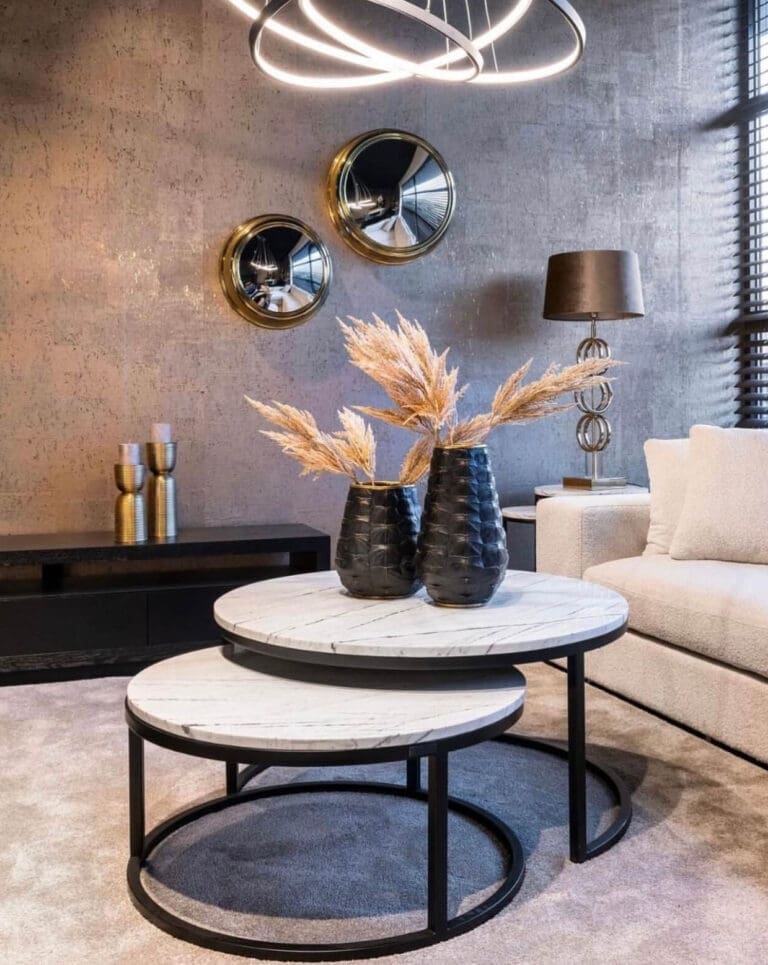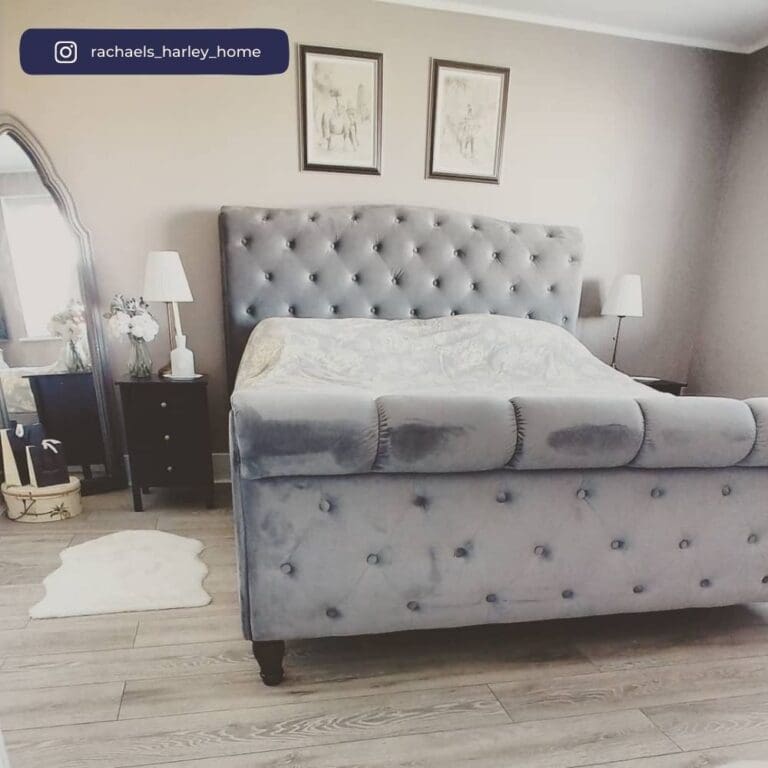Furniture is the skeleton of your home. It gives each room a structure and personality.

But sometimes your furniture can feel like a mess—too many pieces, too little space.
Or sometimes it just doesn’t feel right at all— you know that something’s off, but you’re not sure what.
Is it the colours? The textures? The sizes?
If not, then how about the furniture arrangement?
If a light bulb just went off in your head, and you’re saying, “Yes! That’s it!” this article is for you.
Furniture arrangement or layout is one of the most powerful tools in your decorating toolbox. With it, you can change the entire look and feel of a room with just a few simple adjustments — without even spending a single cent!
So, how do you arrange the furniture in your home?
Here are some ideas:
8 Furniture Arrangement Ideas for Your Home
Symmetrical Furniture Arrangement

You can never go wrong with a symmetrical furniture arrangement. This is the most common type of layout.
The main goal of a symmetrical layout is to create a mirror image. It does not have to be an exact mirror image, but the proportions and look should be similar.
This means that if you have a sofa on one side, you should add a similar seating piece on the other side. The key is ensuring both sides are balanced; otherwise, it can look off-centre or unbalanced.
A symmetrical furniture arrangement is perfect for living rooms, dining rooms, kitchens, and outdoor spaces. However, it can be challenging to pull off in bathrooms and bedrooms.
The main feature of bedrooms is the bed. At the same time, it’s the shower area or bathtub for bathrooms. You don’t need two of these furniture pieces or features, so you can opt for other furniture arrangements instead.
Focal Point Furniture Arrangement

A focal point is a piece of furniture or an area in a room that draws the eye and serves as the centre of attention.
Often, this is a larger piece of furniture like a sofa or an armchair. But it can also be architectural features like a fireplace or a piece of art.
A focal point can stand out because of its size, colour, and texture or even because it’s placed in a spot that catches the eye.
So, how do you pull off a focal point furniture arrangement?
Choose a focal point that can easily stand out. Then, design the room in a way that amplifies the said focal point.
You can do this by following these tips:
- If your focal point stands out due to its size, like oversized furniture, make sure that all other pieces are smaller.
- If your focal point stands out due to its colour, choose neutral or less vibrant colours for the rest of the room’s aesthetic.
- If your focal point stands out due to its texture, make sure that you add pieces with less visible texture.
You don’t have to overthink the process. If you choose the right focal point, the rest of the room will naturally fall into place.

If you don’t have a focal point, a boxed furniture arrangement can be a great way to fill up a space. This layout turns the whole setup into one big focal point.
This kind of arrangement is easy to pull off, especially if you invested in a furniture set. All the pieces are already coordinated, so all you need to do is place them into a box-like formation.
It’s a great way to make a statement without adding too much clutter. It encourages conversation and interaction as people tend to gravitate towards the middle of the room.
A boxed seating arrangement tends to accommodate more people than others because the entire space is surrounded by furniture.
Since all sides are covered, you should leave the middle area plenty of space for people to move around without hindering the flow of conversation or disturbing others.
Circular Furniture Arrangement

Circular furniture arrangement is like another version of a boxed layout. They both offer the same benefits, like encouraging connection and interaction. But in this case, the pieces of furniture are closer together.
However, boxed furniture arrangements tend to accommodate more people than circular ones.
Furniture sets are often placed in a circle, each piece facing the centre. The furniture arrangement doesn’t necessarily have to be circular, though. You can also use a semi-circle or an arc shape as well.
What’s great about this layout is that the space is divided equally among all the furniture pieces. This makes it easy for everyone to see what’s happening and participate in the conversation.
L-Shaped Furniture Arrangement

L-shape furniture arrangements often feature a sectional sofa or are implemented by placing furniture at right angles. This arrangement is a good choice if you have a limited space or have an open-plan layout.
This right-angle arrangement covers two sides of the room, establishing a specific zone and providing a clear division between other areas.
Typically, the open sides of these arrangements have two purposes. The first open side opposite the longest side of the letter L houses the focal point. The second or shorter open side is for entering or exiting the area.
If you have limited space, this arrangement is a good option because you can utilise all the corners of the room.
U-Shaped Furniture Arrangement

A U-shaped furniture arrangement stems from the L-shaped layout with extra seating that makes a U shape.
When you use this layout, you are closing almost all sides of the room, leaving one side open. Keep that open side as interesting as possible so that it doesn’t feel like you are closing off the room.
Your guests will also stay longer if they have something interesting to look at. A TV is perfect for this, but you can also add artwork or something else that will draw the eye.
If you take a look at the letter U, you can see that the sides are wider than the bottom. You don’t necessarily have to follow these proportions. You can make the bottom wide and the sides narrow.
Also, leave some room in the middle so you can move around freely.
Floating Furniture Arrangement

A floating furniture arrangement can be a great choice if you have more windows than wall space.
But what does floating mean? It means that you don’t anchor your furniture to the walls but instead let it sit freely in the room.
Move your furniture a few feet away from the walls to create a feeling of spaciousness. Make sure that the space is enough for a person to walk through comfortably.
This furniture placement prevents the furnishings from blocking the window, thereby letting more natural light into the room. Floating your furniture creates an airy feeling around the room. It also promotes movement throughout the space.
Floating furniture arrangement is a great choice for open-concept homes and larger spaces.
Narrow Furniture Arrangement

As the name suggests, narrow furniture arrangements are for elongated and narrow spaces. These can be narrow living rooms, bathrooms and even hallways.
To do this arrangement, place all the bulky furniture on one side of the wall, like a sofa bed or coffee table. Then, place your decor or slimmer furniture on the other side, like TV stands.
It can be hard to arrange furniture here because there’s not a lot of floor space to work with. But what you can do is use furniture that’s slim and elongated.
That means instead of using a regular round or square coffee table, you can use a rectangular one. You can also use tall furniture like tall boys and mirrors to create the illusion of space.
You can also arrange your furniture in an asymmetrical layout, which means that one side is not the mirror image of the other.
Conclusion
So, have you found the ideal furniture arrangement for your home?
These eight furniture arrangement tips are sure to get you started on the right path.
Remember that there are no rules when it comes to decorating your home—so don’t be afraid to try out all of these furniture placements.
You’ll never know what works best until you see for yourself.


